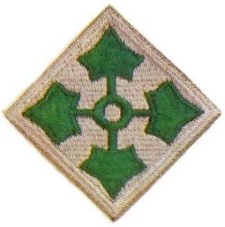4th Infantry Division

The 4th Infantry Division is nicknamed the “Ivy Division. This comes from the design of the shoulder sleeve insignia which has four green ivy leaves joined at the stem and opening at the four corners. The word “Ivy” is a play on the Roman numeral four, IV. Ivy leaves are symbolic of tenacity and fidelity, the basis of the Division’s motto, “Steadfast and Loyal”.
The 4th Infantry Division has a long and distinguished history that includes combat in four wars. Sixteen Ivy Division Soldiers have been awarded the Congressional Medal of Honor and 21 campaign streamers adorn its colors. Additionally, we honor four Soldiers of other units who were awarded the Medal of Honor while their units were attached to the 4th. The Division was formed in December 1917 and was commanded by MG George H. Cameron. Following the United States’ entry into World War I, the Division embarked for Europe as part of the American Expeditionary Force.
The 4th Infantry Division went into action in the Aisne-Marne campaign in July 1918, at which time its units were piecemealed and attached to several French infantry divisions. Almost a month later, the Division was reunited for the final days of the campaign. During the next four months, the 4th Infantry Division saw action on the front lines and reserves. Suffering over 11,500 casualties in the final drive for the Allied victory, the 4th Infantry Division was the only division to serve in both the French and British sectors of the front.
The American people once again called upon the 4th Infantry Division to serve in World War II. From staging areas in England, the Division trained for its major role in Operation Overlord (D-Day)-the amphibious invasion of Europe on 6 June 1944. The Division’s 8th Infantry Regiment was the first Allied unit to assault German forces on the Normandy Coast. The remainder of the Division quickly followed, landing on Utah Beach. For 26 days the Division pushed inland, reaching the Port of Cherbourg and sustaining over 5,000 casualties.
Breaking out of the Beachhead and expanding operations well into France, the Division was given the honor of being the first Allied unit to participate in the liberation of Paris. The Division quickly moved on through northern France reaching Belgium and the border of Germany by September 1944. In November, the Division moved into the Hurtgen Forest and fought what was to be its fiercest battle. The 4th Infantry Division held its ground during the Battle of the Bulge; crossed the Rhine, then the Danube, and finally ceased its advance at the Isar River in southern Germany.
Two decades passed before the Division would again see combat. When the 4th Infantry Division arrived in Vietnam in September 1966, its brigades were deployed to different locations. With the 1st Brigade near the South China Sea (later the Central Highlands) , 2nd Brigade in the Central Highlands, and the 3rd Brigade in the War Zone C, the 4th Infantry took part in 11 major campaigns during its 4 ½ years in Vietnam.
The 4th Infantry Division returned from Vietnam in December 1970 and settled at Fort Carson, Colorado where it reorganized as a mechanized infantry division and remained at Carson for 25 years. It was during the Division’s time at Fort Carson that it had the unofficial nickname of the “Ironhorse” Division. The 4th Infantry Division moved its colors to Fort Hood, Texas in December 1995 to become the Army’s first Digitized Division under the Force XXI program. In this program the Division was thoroughly involved in the training, testing, and evaluation of 72 initiatives to include the Division’s Capstone Exercise (DCX) I held at the National Training Center in Fort Irwin, California in April, 2001 and culminating in the DCX II held at Fort Hood in October 2001.
Division elements have supported rotations to Bosnia and Kuwait as well as providing a Task Force to fight forest fires in Idaho in 2000. 4ID Soldiers supported the Winter Olympics in Utah. Since November 2001, the Division’s mission was the Division Ready Brigade-prepared to deploy at a moment’s notice to anywhere in the world.
In January 2003, the Division received orders for its latest mission. The entire Division loaded their equipment and deployed to war in Iraq. Arriving in March 2004, the Division moved from their Kuwaiti staging areas northward to an area north of Baghdad. Division headquarters was established in Tikrit and the Division’s brigades were located over a large Area of Operations in the “Sunni Triangle”. Thousands of raids and patrols were launched to find remnants of Saddam Hussein loyalists and terrorist operatives who were in the area. One important accomplishment of the Division was the capture, on 13 December 2003, of the former president of Iraq, Saddam Hussein, found just south of Tikrit hiding in a spider-hole. In addition to the wartime and counter-insurgency missions, the Division was instrumental in opening and supplying thousands of schools, hospitals, and clinics within their AO. Division personnel also repaired bridges, roads, power plants, oil pipelines, water mains and many other essential parts of the Iraqi infrastructure.
Returning to Fort Hood in March, 2004 the Division began implementation of a new organizational structure called Modularity.